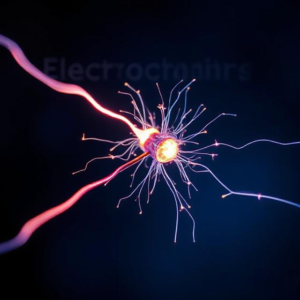An electric field sensor is a device that can detect and measure electric fields in the environment. Electric fields are created by charged objects, like when you rub a balloon on your hair and the balloon becomes charged, creating an electric field around it.

To make it easy to understand, let’s break it down step-by-step:
What is an Electric Field?
- An electric field is a region around a charged object where other charges (like electrons or protons) experience a force. For example, a charged balloon creates an electric field around it, and if you bring another charged object near it, the object will feel a force due to that electric field.
- Electric fields are all around us because many objects have electric charges, and these charges generate fields that can affect other charges in the vicinity.
What Does an Electric Field Sensor Do?
An electric field sensor detects the presence and strength of these fields. It doesn’t directly measure the charge of an object, but it measures the effect that the electric field has in a particular area. These sensors are sensitive to the invisible electric fields created by charged objects or electrical activity.
How Does it Work?
The basic working principle of an electric field sensor involves measuring the electric force on a small charged object (like a metal electrode) in the presence of an electric field. When the sensor is exposed to an electric field, it experiences a force, and the sensor can detect this force, translating it into a measurement.
Electric field sensors typically use one of the following methods to detect the field:
- Capacitive Sensors: These sensors use the concept of capacitance—which is the ability of two objects to store electrical energy in an electric field. When a nearby electric field changes, the capacitance between the sensor’s electrode and a nearby object changes, and the sensor detects this change.
- Field Effect Sensors: These sensors use the field effect, where the sensor’s response changes depending on the strength of the electric field. The electric field affects the flow of charge carriers (like electrons) in the sensor, and this can be measured.
- Induced Charge Measurement: The sensor can measure the charge induced on its surface by the nearby electric field. The amount of charge detected gives information about the strength of the electric field.
What Are Electric Field Sensors Used For?
Electric field sensors are used in various applications, including:
- Detecting static electricity: They are used to monitor static electricity in environments where electrostatic discharge (ESD) could damage sensitive equipment, like in electronics manufacturing.
- Measuring environmental electric fields: For example, in research or weather monitoring, electric fields can be influenced by nearby thunderstorms. Sensors help detect these changes in the field.
- Touchscreens: Some touchscreens use electric field sensors to detect your finger’s position and the electric field created by it when you touch the screen.
- Electromagnetic field (EMF) detection: Electric field sensors can be part of systems that detect electromagnetic fields, which are produced by electrical devices, power lines, and communications systems.
- Safety and diagnostic tools: They are used to detect faults in electrical equipment or systems by measuring the electric fields that appear due to electrical malfunctions.
Simple Analogy:
Think of an electric field sensor like a “wind gauge” for electric fields. Just as a wind gauge detects the strength and direction of the wind, an electric field sensor detects the strength and direction of electric fields. The stronger the electric field (like a stronger wind), the more the sensor will respond.
Key Points:
- Electric field sensors detect the presence of electric fields in the surrounding area, not the charge itself.
- They measure how much the electric field influences their surroundings (like a “force” on the sensor).
- These sensors are used in industries, electronics, and research to monitor and measure electrical activity and static charges.
In Summary:
An electric field sensor helps us measure the invisible electric fields around us, which are created by charged objects. These sensors are essential in various fields like electronics, safety, and research, helping us detect and manage electrical activity or static electricity.











